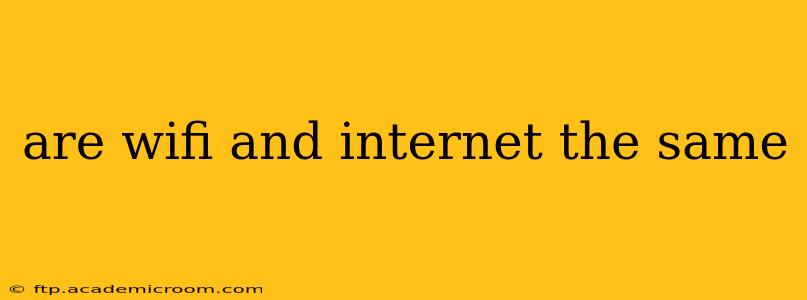While often used interchangeably, WiFi and the internet are not the same thing. They are closely related, but distinct technologies that work together to provide internet access. Think of it like this: the internet is the vast highway system, and WiFi is one specific type of on-ramp. Let's explore the key differences.
What is the Internet?
The internet is a global network of interconnected computer networks. It's a massive, decentralized system that allows billions of devices worldwide to communicate and share information. This information exchange happens through various protocols, primarily using the TCP/IP protocol suite. The internet allows you to access websites, emails, online services, and much more. Without the internet, none of this would be possible.
What is WiFi?
WiFi (Wireless Fidelity) is a wireless networking technology that allows devices to connect to the internet (or other networks) without the need for physical cables. It uses radio waves to transmit data between a router and devices such as computers, smartphones, and tablets. Think of your home WiFi router as a local access point to the internet highway.
How do WiFi and the Internet work together?
Your WiFi router acts as a bridge between your local network and the internet. Your devices connect to your WiFi router wirelessly, and the router then connects to your internet service provider (ISP) through a physical connection (usually a cable or fiber optic line). Your ISP then provides the gateway to the vast network that is the internet.
In short: You need an internet connection to use the internet, but you don't necessarily need WiFi to access it. You can connect to the internet through other means, such as Ethernet cables.
Can I have the Internet without WiFi?
Absolutely! Many ways exist to connect to the internet without using WiFi. These include:
- Ethernet Cable: A wired connection directly to your modem or router offers a consistently faster and more stable connection than WiFi.
- Mobile Hotspot: Your smartphone can create a mobile hotspot, sharing its cellular data connection with other devices.
- Satellite Internet: Satellite internet uses satellites to provide internet access, particularly useful in areas with limited or no other options.
- DSL or Dial-up: While becoming less common, DSL and dial-up connections use existing telephone lines to provide internet access.
What are the differences between WiFi and the Internet?
Here's a table summarizing the key differences:
| Feature | WiFi | Internet |
|---|---|---|
| Nature | Wireless networking technology | Global network of interconnected networks |
| Connection | Wireless (radio waves) | Wired or wireless |
| Scope | Local area network (LAN) | Global network |
| Access | Requires a router/access point | Requires an ISP |
| Speed | Variable, affected by interference | Variable, dependent on connection type |
| Security | Can be secured with passwords, etc. | Security measures vary across networks |
Is WiFi a type of internet access?
WiFi is not a type of internet access, but rather a method of accessing the internet. It's a technology that enables wireless connection to a network, which might be connected to the internet, or might be a completely separate, private network.
What is the difference between a router and a modem?
Many people confuse routers and modems. Here's a quick explanation:
- Modem: Modulates and demodulates signals, essentially translating the digital data your computer uses into signals that travel over your internet connection (cable, fiber, etc.) and vice versa. It connects your home network to your ISP.
- Router: Routes data between devices on your home network and the internet connection provided by the modem. It manages the traffic and assigns IP addresses to devices on your network. You need both a modem and a router to access the internet at home.
Understanding the difference between WiFi and the internet is crucial to troubleshooting connectivity problems and making informed decisions about your home network. Hopefully, this explanation clarifies the distinction and helps you better understand how both technologies work together.
